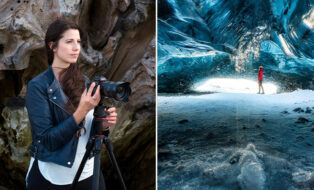Admittedly it is hot. We’ve just stepped off a plane in Alice Springs, out of a safe, air conditioned environment and into the midday heat of Central Australia. The hot air hits you like a wall and, considering it is winter back home, we enjoy the difference just long enough before stepping back into an air conditioned vehicle.
The vehicle is not a bus, nor is it a truck, but a four-wheel drive hybrid with a trailer, designed to carry passengers along rough and remote outback tracks. You don’t want to get stuck in the Outback without being prepared and our vehicle has food and water supplies to last us a week, plus a satellite phone to ensure we have contact with the outside world. Later in the trip, we would be leaving the marked roads and following a pencil sketch on a torn piece of paper through some of Australia’s most inaccessible terrain.
Tonight, however, would be relatively civilized. We were heading to Rainbow Valley just 75 kilometres south of Alice Springs. Rainbow Valley is a part of the James Range, but the ranges in the relatively flat Red Centre are more like hills than mountains. The main feature to photograph is a salt pan sitting in front of a multi-coloured bluff. Some of the most interesting photos have the bluff reflected in water, but today the salt pan is bone dry with a few tumbleweeds scattered along its edges. There hasn’t been significant rain here for many months.
Sunrise is interesting, but you’ll probably find that the bluff is in shadow, whereas at sunset we have the escarpment in full light. And our shadows in the foreground, so we skirt around the edge of the salt pan, looking for some existing shadows to hide in, so our presence isn’t obvious. The other option is to wait for the sun to set and then shoot in the twilight. Central Australia is simply magnificent to shoot at this time of the day and by now, the temperature is very comfortable.
Tonight we will sleep under the stars in a swag. A swag is a large canvas bag with a comfortable mattress, sheets and blankets inside. You can be sure it won’t be raining! You simply pull it off the top of the truck, unroll it and climb inside. It’s like a big sleeping bag and there really is nothing better than lying on your back and looking up at the stars, the camp fire crackling in the background as you drop off to sleep…
However, sleep takes a little longer as we can hear the howls of dingoes in the distance. Our guide is unperturbed, so we take our lead from him and cover up our heads with the flap on the end of the swag. Later that night I wake to the sound of scratching near the fire. The embers are now just a glow and I can see the silhouetted legs of a couple of dingoes, scavenging for an easy meal.
Good thing they don’t eat humans. Often.
Post-Production
My image of Rainbow Valley (above) was taken with an Alpa TC, a 23mm Rodenstock Digaron lens and a Phase One IQ180 digital back. I positioned the camera very low and very close to the tumbleweed and took several frames at different focus points, so I can focus stack an image if necessary. However, I quite like the softness on the bluff in the background.
After applying some global adjustments to the colour, saturation and cropping, there were two main challenges to deal with and the first was easily solved. The bright sky needed to be balanced with the darker foreground, so I used a Local Adjustment in Capture One Pro 7 with the new Gradient Mask. This allowed me to darken the top of the frame and gradually reduce the effect towards the horizon line (see above).
The second challenge was to allow the tumbleweed to stand out from the cracking mud below. Although the wood in the tumbleweed is partially bleached, it is nevertheless coated with dust and sand, much the same colour as the mud behind. It is well camouflaged.
I would like to avoid creating a very fine mask for the tumbleweed itself, so I begin by increasing the colour in the foreground mud (above). I add a Local Adjustment layer and open the Advanced Color Editor. Using the Pick Color Correction eyedropper tool, I click on the mud to select the colour range and then I use the Saturation slider to increase the colour. It helps, but still the tumbleweed blends into the background.
I then added a four more Local Adjustments, lightening and darkening the areas surrounding the tumbleweed, but with no real success. It seemed that the only option was to create a fine and complicated mask for the tumbleweed’s branches.

This is what I had tried to avoid because creating precise masks can be time consuming, especially if your subject has lots of edges. Like a tumbleweed! I have cheated a little because this version of the image is only going to be 2000 pixels in size, so slight errors in my masking technique won’t be too obvious I hope! However, if you’re wanting to keep your workflow within Capture One, the masking tools are here. In addition to size and hardness, Capture One Pro 7 also has an opacity slider to adjust, so there is very little lacking in the application’s masking capabilities.
With the mask completed, the tumbleweed is lightened to ensure it stands out from the mud. I then went back and refined the other settings to produce the result seen at the beginning of this post.
Cheers,
Peter
Peter Eastway is a professional photographer and photography magazine editor based in Sydney, Australia. If you would like to accompany Peter and Tony Hewitt on a seven day Central Australia ‘Adventures in Oz’ workshop in August 2013, click here for more information.
And if you’d like to see a short movie explaining in more detail how Peter processed this file in Capture One,
click here.
To see more of Peter’s photography, visit www.petereastway.com. Peter also offers an online Landscape Photography MasterClass. It contains articles and videos, outlining his camera and post-production techniques. Details can be found at www.betterphotography.com.
Peter Eastway
Peter Eastway’s passion is undoubtedly for landscape photography, but he is equally comfortable with portraiture, advertising and travel. He is currently an AIPP Grand Master of Photography, one of only a dozen in Australia and earned from a career spanning over 30 years.








Hi Peter,
Interesting but I have a burning question.. What about the veracity of the image? Is what I now see what you really saw or an enhanced version of it? In my view there is a real difference between ‘clarity’ (clarification of the original as Adobe provide) and ‘modification’ of the image.
I welcome your honest comment.
Thanks for your query imagetutor, but what do you mean by veracity? The fact that a camera cannot interpret what we see with our eyes and our mind? That an electromechanical device somehow creates a more accurate rendition of what we saw, felt and experienced? Photography is a language. You can use it for scientific research or you can use it to write poetry and fiction. I’ve shown the original capture which is not what I felt or experienced. My eyes and my brain adjusted my experience while I was in Rainbow Valley. When I was there, the tumbleweed stood out to my 3D image sensors, but was lost in the 2D rendition of the camera. I ‘feel’ that the resulting image is much closer to my ‘experience’, both adjectives used subjectively. Personally, I don’t believe in the objectivity of photography – it can never be truly objective or ‘clear’ for so many reasons. The simple act of putting a frame around a scene or a subject means it is no longer objective, but now we are getting very philosophical and this type of conversation is best had over a glass of red wine!
Hi Peter,
Thanks for taking time out to reply. I appreciate it – and thanks too for giving a sense of ‘feel’ to the image. i have seen these colours myself up around Kilbarry National Park, north of Perth when visiting my son. The always appear a little unreal. As for veracity, that’s me being pedantic, insisting on the ‘truth’ in an image. But, next time I am down under, i’ll stand you that glass or three of red and we can discuss it! Thanks again..
p.s. FOCUS on Imaging next week at the NEC Birmingham – looking to catch a look at the IQ backs… D